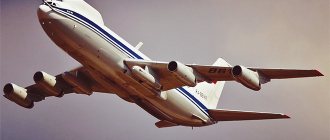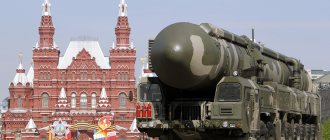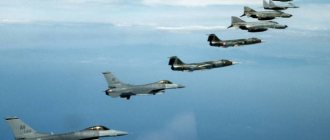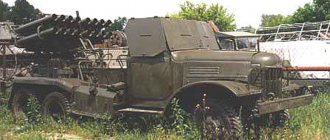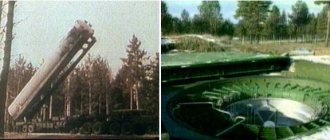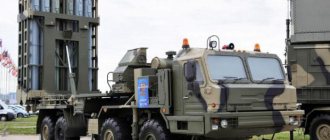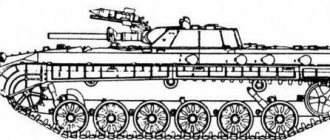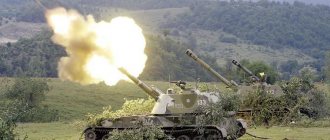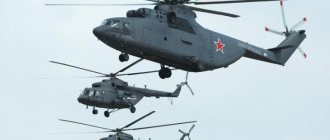Mobile command post of the missile division of the Russian Strategic Missile Forces
The Rdn PKP includes four units: a combat control vehicle (MBU), a communications vehicle (MS-2) and two combat duty support vehicles (MOBD).The MBU is designed to organize and carry out combat duty by the command post crew, continuously monitor the parameters of the launcher and missiles, prepare and conduct missile launches. The unit, based on the MAZ-543 chassis, contains combat control equipment, communications equipment (HF, VHF, DV, VHF receivers and a space communications station, a service set of communications equipment for controlling a communications vehicle on the move). Structurally, the unit has 5 compartments: an entrance vestibule (a set of spare parts for the unit and communication equipment is located), a combat compartment (the direct location for carrying the database, housing receivers, communication control panels, an operator’s console and a commander’s console), a special communications compartment (a corresponding set of equipment), a hardware compartment (racks of combat control equipment), aggregate compartment (equipment of SES and life support systems).
MS-2 is designed to organize and carry out combat duty by a communications crew on the march or in the field area. The task is continuous monitoring of the performance of transmitting devices of communication equipment. It has its own power source to ensure the operation of transmitting devices on the move (two 12 kV ADA-12 diesel generators). Base – MAZ-543 chassis. Structurally, it has three compartments. The first is the hardware compartment (communication equipment and the SES control unit, life support systems are housed), the second is the combat compartment (the immediate duty station of the communications crew and the placement of part of the transmitting equipment), the third is the diesel compartment (two ADA-12 diesel units are housed).
The MOBD is designed to provide consumers with electricity at a field position and in an emergency at the BSP; in addition, it is a support machine (preparing and eating food, resting personnel free from the database) for organizing and performing guard duty (the RDN includes the chief of guard and the final link of the entire system guards are located in MOBD-5, unit MS. In a dispersed manner, senior APU and NK operators are on duty in MOBD-1,2,3, MOBD-4 is guarded by the control panel). Base – MAZ-543 chassis. Structurally, the unit is made of two rigidly disconnected compartments. The first compartment is diesel (4 30KV diesel engines and a diesel control unit in manual mode are housed). The second compartment is the main one. Between the first and second compartments there are fuel tanks with a fuel supply of 4 tons for the ADA-30. The second compartment includes: a kitchen (a stove for cooking, compartments for storing food, a refrigerator, a place for storing dishes and washing them), a dining room (for meals for personnel, 4 people can eat at the same time), two 4-seaters compartment for rest of personnel, double compartment for rest of the NK, combat compartment (terminal equipment of the security system, APU operator console (for 1,2,3 MOBD), turret-machine gun installation for the security machine gunner (NSVT machine gun, searchlight, IR searchlight, device night vision), safe and weapons pyramid). Along the entire left side from the combat compartment to the dining compartment there is a service corridor (similar to a train corridor), it contains a washbasin and compartments for drying outerwear and shoes.
Combat duty support vehicle for the Strategic Missile Forces (MOBD)
In this photo report we will see what a very interesting piece of equipment looks like from the inside - the combat duty support vehicle (MCMS) of the Strategic Missile Forces (Strategic Missile Forces). I met this car at the rock festival “Invasion 2013” in the Thematic Zone of the Ministry of Defense of the Russian Federation. Since I have always liked such equipment and “doomsday” structures, I really asked the military to show what this car looks like from the inside. And so, a special vehicle of the Strategic Missile Forces - MOBD (unit 15B231) is designed to provide:
— electric power from consumers at the field position and in case of an emergency at the combat starting position;
— preparation and consumption of food by personnel;
— rest and life of personnel free from combat duty in the field;
— organizing and performing guard duty in the field;
— launching nuclear missiles from the MOBD when operating in field conditions.
The dimensions and equipment of the unit are designed to support 10 people with personal belongings and weapons.
TECHNICAL DESCRIPTION
The design of the unit and the equipment installed on it ensures its operation at any time of the year and day, under any metrological conditions (rain, snow, hail, fog) in the ambient temperature range from -50°С to +50°С, at ground wind speed up to 25 m/s and relative ambient humidity up to 98% (at a temperature of +25 ° C). The unit includes systems for power supply, control, communications, microclimate, heating, ventilation, water supply, warning, kitchen, storage and household equipment.
The 15B148 unit (modification) is mounted on a MAZ-543M all-terrain wheeled chassis.
The unit includes:
• all-terrain wheeled chassis;
• body mounted on a chassis;
• equipment mounted on the chassis and in the body.
Structurally, the unit is made of two rigidly disconnected compartments.
The body has an index of 7903. The bodies of the 15B148 unit compartments are an all-metal welded structure, consisting of a frame with a base, outer and inner cladding, floor, removable panels, doors and hatches. The outer skin of the body is made of steel sheets 1mm thick, the inner skin is made of panels glued together from bakelized plywood sheets 5mm thick and decorative plastic. The heat and sound insulation of the body is made of heat and sound insulating material MM-1 5011, which is used to fill the frame cells between the outer and inner skins. The flooring has two layers: the bottom layer is made of NSVS foam plastic, the top layer is made of baked plywood. All windows are double glazed with rubber seals and locks. The windows are equipped with blackout curtains and insect protection nets.
The first compartment is diesel.
The diesel compartment contains TWO diesel-electric units AD-30 with a power of 30 kW and an AD control unit in manual mode. To eliminate the transmission of vibration from the diesel compartment to the main compartment, the diesel compartment is mounted on damping devices, which are fixed when the unit is marching. In the side walls of the first compartment of the body there are two single-leaf doors and hatches for the intake and exhaust of air from the radiators of the units. To reduce the noise level of the IM exhaust, the 15B148 unit is equipped with a vertical type exhaust pipe with a compensating device (4 m long pipe covered with asbestos-gypsum cord).
Between the first and second compartments there is a fuel tank with a fuel supply of 2,398 liters for the IM.
MOBD. Combat duty support vehicle. Part of the mobile group of the Strategic Missile Forces.
In the corridor there is an electrical panel and a radiation and chemical reconnaissance device GO-27
The second compartment is the main one.
The main compartment inside the body is divided by partitions into seven compartments for various purposes. The side walls of the second body compartment have two external doors and seven windows. The compartment is equipped with an air conditioner, an OV-65 heating and ventilation unit and an FVUA-100V-24 filter and ventilation unit.
Three compartments are used to accommodate people - two 4-berth compartments for resting personnel and a 2-berth compartment for resting the NK and his assistant.
There is a compartment-dining room for meals for personnel - 4 people can eat at the same time. The dining room compartment is equipped with one folding bed for the cook. The kitchen compartment has a stove for cooking, food storage compartments, a refrigerator, and space for storing dishes and washing them.
compartment-dining room for staff meals
OPERATION (COMbat USE)
It has been in service with the Strategic Missile Forces since 1985.
Used in PGRK:
— 15P158.1 “Topol-T”;
- 15P158 “Topol”.
The middle compartment (vestibule) and the rear operator's compartment are connected by a corridor that runs along the entire left side from the combat compartment to the dining compartment (similar to a train corridor); it contains a washbasin and compartments for drying outerwear and shoes. From the corridor there are entrances through internal sliding doors to the compartment and operator's compartment, from the vestibule to the dining room, from the dining room to the kitchen. The vestibule is equipped with an entrance door.
In such a cozy environment, you can comfortably go to the position from which you will destroy the world)
The operator's rear combat compartment is designed to accommodate the duty shift; it contains the operator's combat post (for MOBD-1,2,3) and the BPU gunner's post. The compartment contains the terminal equipment of the security system, the APU operator console (for 1,2,3 MOBD), a safe and a pyramid for weapons. A turret-machine gun mount (BPU) 55L140 “Luch” is mounted on the combat compartment.
Also, on the combat compartment, next to the control unit, there is a device for raising and lowering a whip antenna (AS) 2 m long for the R-173 radio station. As part of the RDN, the chief of guard and the final link of the entire security system are located in MOBD-5, the MS unit. In a dispersed manner, senior APU and NK operators are on duty in MOBD-1,2,3; MOBD-4 is guarded by the control panel. In MOBD-4, in the operator’s compartment there is a post for the security and defense shift supervisor. In the case of carrying the database in a dispersed manner, the operator in MOBD 1,2,3 is also the head of the security and defense shift; all information from the security system is displayed in the compartment.
A military man at the control panel for launching nuclear missiles in action in the field, despite its 30 years of age, the equipment is still secret and is in service with the Strategic Missile Forces
“Everything is simple with us, I pressed the button, and there is no more America..”
Yes.. everything is serious there, and as they say in the Strategic Missile Forces, “After us, there is no one”
https://jury-tver.livejournal....
Command and staff vehicles of the USSR Armed Forces
The post-war radio communication system of tactical and operational command and control levels as a whole no longer met the tasks being solved by the troops. Therefore, the need arose to create mobile headquarters control points equipped on vehicles. In addition, the all-terrain vehicles used were equipped with separate elements that, when deployed, ensure the relatively quick creation of comfortable jobs for the operational staff of the control body, as well as their protection from adverse weather conditions and work at night. In some cases, the survivability of control points was increased by replacing the vehicle chassis of the KShM with the chassis of the main military models, which had higher maneuverability and armor protection.
KShM command and staff vehicles are combat control vehicles equipped with communications, as well as other technical means, from which commanders and staffs control troops during preparation and conduct of combat duty/combat operations
Type: BMP-1KSh “Potok-2” (object 774) Command and staff vehicle based on the BMP-1. Serves as a command post for a motorized rifle or tank regiment.
The BMP-1KSh was developed in Chelyabinsk at the design bureau under the leadership of P.P. Isakov. Commissioned in 1972. Serial production was organized at the Rubtsovsky Machine-Building Plant in 1976.
The KShM equipment is mounted in the BMP-1 body.
The equipment includes:
- Radio station R-123MT
- Radio station R-130,
- Radio station R-111 (2 pcs.)
- Automatic device for ensuring the secrecy of negotiations 1T-219M
- Automatic call device R-012
- Navigation equipment TNA-3.
- There is a gas-electric unit to power the equipment.
- The machine is equipped with an autonomous heating and ventilation unit.
The driver is located in the bow of the hull. Radio equipment and 2 radio operator workstations are mounted in the rear section. In the center of the building are the workplaces of 4 staff officers. The tower is fixed motionless. Instead of a gun, a lifting telescopic antenna mast was mounted (length in the extended position is 16 m). There are 2 hatches on the roof of the hull behind the turret. The armament consists of a PK machine gun (ammunition capacity of 2000 rounds), transported in a pack.
Type: BTR-50PU
Command and staff vehicle based on the BTR-50P.
Accepted for service on 04/11/1959. Serially produced at the Volgograd Tractor Plant (Chelyabinsk?) since 1959.
The vehicle was equipped with 10 workplaces - for the formation commander, the vehicle commander, the driver, four radio operators and three staff officers. There was a sliding table for working with the map.
The equipment includes:
- Radio station R-113
- Radio station R-112
- Radio station R-105 (R-105U) (2 pcs.)
- Two-channel radio relay station R-403BM
- Telephone switch for 10 subscribers P-193M
- Radio receiver R-311
- Petrol-electric unit AB-1-P/30.
The vehicle was equipped with a safety system, a heating and ventilation system, and tank navigation equipment.
Modifications
Type: BTR-50PU (object 705K)
Type: BTR-50PUM – modernized.
Type: BTR-50PUM-1 – modernized. Commissioned in 1972.
6 + 4 – crew + workplaces for officers
The equipment includes:
- R-112
- R-113
- R-105 with BUM
- R-105
- R-403BM
- R-311
- R-124 2 rooms
- P-193M
- TA 4 pcs.
- P-275 2.4 km.
- ON KN-2
- AT KP-2
- AB-1-P/30
- PVN-2B
Type: BTR-50PUM
6 + 4 – crew + workplaces for officers
The equipment includes:
- R-123 3 pcs.
- R-130
- R-326
- R-405D
- T-218
Type: BTR-50PUM-1
The equipment includes:
- R-123MT
- R-111 2 pcs.
- R-130M
- R-326
- R-405MPT1
- specialist. equipment.
- AB-1-p/30
Type: R-125 “Alphabet”
Purpose: divisional command and staff vehicle of motorized rifle and tank forces.
Designed for radio communication in the range of 1.5 - 10.99 MHz and 20 - 51.5 MHz when parked and while the vehicle is moving.
The R-125 command and staff vehicle was created to provide radio communications to unit commanders and service chiefs of the ground forces and was a further development of the use of the automobile version of the R-104 “Kedr” radio station.
The equipment of the KShM R-125 included:
- 1 HF r/station R-104M
- 2 VHF radio stations with UM-1 power amplifiers.
In addition to the version on the GAZ-69 chassis, the Radiopribor plant produced a KShM version on the GAZ-63 chassis. The body was manufactured at a furniture factory in Rechitsa and equipped with compartments for the commander and radio operator. The internal communication equipment (AVSK) provided the commander with communication with the radio operator and driver, including from the remote communication console in the parking lot and communication with the desired subscriber via any of the channels provided in the communication center. Power supply for communication equipment was provided while driving from a power take-off generator from the engine, and when parked - from an autonomous remote petrol-electric unit (ABE), backup batteries were provided as an emergency power source for the equipment, which were recharged from the on-board network through a charger while driving.
Type: R-125B “Belozor”
Command and staff vehicle for providing radio communications in the division-regiment link based on the UAZ-469.
The equipment includes:
- Radio station R-123 (R-123M, R-173) (2 pcs.)
- Radio station -130 (R-130M, R-130M2)
- Radio station R-809M2.
- Switching equipment R-014D
MODIFICATIONS:
Type: R-125BR “Belozor-1” based on UAZ-469
Type: R-125B-1 Belozor-1
Purpose: Corps Commander's KShM.
The command and staff vehicle was created to provide radio communications to unit commanders and service chiefs of the ground forces.
The equipment includes:
- Radio station R-143
- Radio station R-159
- Switching equipment R-012M
- BCC (centralized switching unit)
- PDU (power distribution unit)
- TS (light display)
- BA (battery pack for 2 backup batteries 6ST-75) Petrol unit AB-1-P/30
- Loudspeaker, mast, antennas, headsets, etc.
Type: R-125B-2 Belozor-2
KShM of the district (front) commander
The equipment includes:
- Radio station R-134
- Radio station R-173
- Radio station R-158
- Radio station R-809M (supplied as a separate order)
- T-219M (ZAS equipment)
- R-012M
- BCC (centralized switching unit)
- PDU (power distribution unit)
- TS (light display)
- BA (battery pack for 2 backup batteries 6ST-75)
- Petrol unit AB-1-P/30
- Loudspeaker, mast, antennas, headsets, etc.
Type: R-125B-2M “Belozor-2M” based on UAZ-452
Type: R-125B-2M1 based on UAZ-452
Type: R-125B-2M2 based on UAZ-452
Type: R-125B-2M4 based on UAZ-452
Type: Type: R-125MT2 “Alphabet-MT2”
Purpose: command and staff vehicle of the Ministry of Internal Affairs
The KShM equipment is mounted in an ABC-2M-01 body on the chassis of a GAZ-66-04E vehicle.
The equipment includes:
- Radio station R-130M
- Radio station R-123M
- Radio station R-105M 2 pcs.
- UM-3 2 pcs.
- Radio receiver R-326
- R-012
- TA-57 3 pcs.
- P-180M
- AB-1-P/30
Type: R-142 “Deimos”
Purpose: regimental command and staff vehicle
The frequency range of the radio station is 1.5-30 MHz (1.5-29.9999 MHz).
The frequency grid is discrete with intervals of 100 Hz and multiples of 100 Hz.
The time for automatic tuning of a radio station from one frequency to another when switching to any of ten pre-prepared waves is 30 seconds.
The power supplied by the transmitter in telegraph or telephone single-channel mode at a 3 percent level of the carrier frequency and a single-tone modulating signal is not less than 1000 W, except for the end of the IV subband in the frequency band 14.8-15.9999 MHz and the end of the V subband subband in the frequency band 28.8-29.9999 MHz, where the power is at least 850 W.
GAZ-66 chassis with a KF-1M or K66N van body. In the hardware compartment of the vehicle body there are two workstations for radio operators and the main part of the KShM radio equipment is located:
The equipment includes:
- Radio station R-111 “Binom-M” – 2 sets;
- Radio station R-130M “Boxwood” with power supplies and self-propelled guns;
- Radio station R-123MT "Magnolia" with power supply unit BP-26,
- Equipment R-011 and R-012,
- Radio operator's console PR.
- ZAS T-219 “Yacht”
Type: R-142NE “Deimos-NE”
Purpose: regimental command and staff vehicle
The command and staff vehicle (combined radio station) R-142NE is designed to organize communications at the operational-tactical control level. in motion and in a parking lot, both autonomously and as part of a communication center, in moderately rough terrain, at any time of the day or year, at frequencies in the range from 1.5 to 79.975 MHz.
The KShM equipment is installed in a heated metal body on the transport base of a GAZ-66 vehicle.
Type: R-145BM “Chaika-BM”
Purpose: battalion command and staff vehicle
KShM R-145BM “Chaika-BM” is a mobile complex mounted on the basis of the BTR-60PA (BTR-60PU) armored personnel carrier.
The equipment includes:
- HF radio station R-130M “Boxwood”;
- Dual simplex version of the VHF radio station R-111 “Binom-M”;
- VHF radio station R-123MT “Magnolia”;
- Call device R-012M;
- Equipment set ZAS T-219 “Yacht”;
- Set of switching equipment;
- Set of antenna mast devices;
- Power supply system:
- Generator G-290;
- Petrol-electric unit AB-O/230.
The command and staff vehicle (CSV) R-145BM “Chaika-BM” is designed to provide control and organization of radio communications at mobile control points via one HF and three VHF channels, both in motion and when parked, at the same time via one of the r/stations communication can be carried out using ZAS. The KShM can operate both in the US PU system and autonomously.
Type: R-146 “Umbrella”
Air defense command and staff vehicle
The R-146 “Umbrella” air defense command and staff vehicle is designed to provide communications in anti-aircraft missile units.
The equipment includes:
- Radio station R-111 2 pcs.
- Radio station R-123M
- Radio station R-107
- Radio station R-405M
- Radio station R-407
- St-2M or STA-M67
- Radio receiver R-326 3 pcs.
- TA-57 3 pcs.
- P-193M
Author of the publication
offline 4 months
Alexander
0
QTH - Donetsk, DPR.
Comments: 10Publications: 1119Registration: 11-08-2015
Coastal missile system "Bastion": technical characteristics
The Bastion mobile coastal missile system (CBM) provides protection for a coastline over 600 km long from enemy landing operations, the far frontier of a political-administrative region as part of a unified coastal defense system.
The time from receiving an order on the march to full deployment to combat positions is five minutes, after which the complex is completely ready for firing. The position of the complex can be 200 kilometers away from the coastline. After its deployment, the PBRK can remain in full combat readiness for 3-5 days, depending on available fuel reserves.
The composition of the Bastion PBRK includes:
— Yakhont anti-ship missiles in a transport-launch canister (TPS);
- self-propelled launchers K-340P on the MZKT-7930 chassis (crew - three people);
- combat control vehicle (crew - five people);
— equipment for information and technical interface of the complex’s combat assets with the main command post;
— automated combat control system for the complex;
— a set of technical maintenance equipment.
A fully fueled and equipped rocket is stored in a sealed TPS with compactly folded wings and tail surfaces. The necessary routine checks are carried out without removing the missile from the TPS.
In addition to the Bastion anti-ship complex, they can be supplied:
— transport-loading vehicles K-342R;
— combat duty support vehicles;
— educational and training facilities;
- helicopter target designation complex.
The Bastion mobile coastal missile system with Yakhont anti-ship missiles has the following advantages: full autonomy of the combat use of anti-ship missiles, a set of adaptive flight trajectories and high supersonic speed along the entire trajectory. The complex is also distinguished by high combat effectiveness in electronic and fire countermeasures, high mobility and stealth. At the same time, it is compact and requires a minimum amount of maintenance and a minimum combat crew.
Main tactical and technical characteristics of the PRK:
Flight range: along a combined trajectory - up to 300 km, along a mixed trajectory - up to 120 km.
RCC flight altitude: on the cruising section - up to 14,000 meters, on the final section of the trajectory - 10-15 meters.
Maximum flight speed of anti-ship missiles: 750 m/s.
Rocket weight: launch - 3000 kg, with TPS - 3900 kg.
TPS dimensions: length - 8900 mm, diameter 720 mm.
The mass of the warhead is 200 kg.
Control system: inertial navigation system, radio altimeter, radar homing head.
Start-boost stage: solid propellant.
Main engine: type - ramjet jet engine, fuel - T-6 kerosene.
In November 2016, Bastion coastal missile systems were used to destroy ground targets in Syria, which became the first combat use of the complex against ground targets in history.
The material was prepared based on information from RIA Novosti and open sources
Communication, detection and control machines
Communication, detection and control machines
A wide range of various autonomous radio engineering and command vehicles for highly specialized purposes was created in the USSR since the early 1960s with a focus on ensuring the most covert and effective combat use of promising mobile strategic missile systems. All these mobile vehicles were mounted on MAZ-543A and 543M chassis, equipped with standard habitable bodies with special equipment, autonomous power units, antenna devices, combat security equipment and life support systems. When on duty in sparsely populated regions, mobile power plants or an industrial power grid served as energy sources, and mobile canteens and dormitories were used for rest and food for the combat crew.
Communication vehicle MS-1 (15B82) of the Pioneer UTTH complex in body 2212 on a MAZ-543A chassis
Universal-purpose equipment includes communication vehicles of various configurations from the Krasnodar Instrument Plant (KPZ), which bore the generic names MS-1 and MS-2 and were designed primarily for use as part of mobile command posts of various strategic missile forces. Communication machine No. 1 or MS-1 was used to organize tropospheric radio communications with higher levels of control. Initially, its short- and ultra-short-wave lamp equipment was located in the equipment room of a medium-sized glazed body 2212 on chassis 543A, in the second compartment there was a combat duty room with racks and boxes for weapons, in the third there were two autonomous diesel generators ADA-12 with a power of 12 kW each. The body was equipped with heaters, a filter-ventilation unit or air conditioning, and several telescopic and whip antennas were installed on the roof. For the first time in the 15B57 version, the MS-1 vehicle was used in the command posts of the Temp-2S, Pioneer and Pioneer-K SRK. Then, in the 15B82 version, it was part of the Pioneer UTTH SRK, and in the divisions of the Topol complexes it served in the 15B179 version with modernized electronic-based equipment. As part of the mobile reserve command post 15B119 of the “Vybor” missile division, it was under the index 15B133.
Communications machine No. 2 or MS-2, better known as the heavy radio relay station R-406HF "Torf-2" of the highest command level, was developed in 1960 by order of the Strategic Missile Forces and put into service in 1963. Together with other means, it was part of the mobile command posts of the Strategic Missile Forces system and served to organize radio relay communications with the General Staff, army and front headquarters, to organize communications and control in units of missile systems on the move, in deployment areas and to monitor the performance of all elements of the complexes . The first samples of MS-2 were mounted on the 543A chassis, but from the mid-1970s the MAZ-543M became its basis. Their equipment room with an ultra-short wave complex of transceiver devices 15E1061 "Keychain" and the duty crew room were located in two compartments of a short sealed control cabin, which was the front part of a standard van body 6702. On the open rear section of the vehicle frame there was a folding antenna-mast device with a set of two tropospheric communication dish antennas. As part of the Strategic Missile Forces, for the first time, under the designation 15B75, the MS-2 vehicle was included in the regimental mobile command post “Barrier” of the Temp-2S and “Pioneer” combat missile systems; the 15B175 variant was part of the “Topol” complex. In the mobile reserve command post 15B119 of the Vybor missile division, it was designated 15B134.
MS-2 communication vehicle (R-406VCh “Torf-2”) with an antenna-mast device based on MAZ-543M
The second, even more numerous category consisted of autonomous preparation and launch vehicles (MPV), which were part of the mobile command posts of divisions of various missile systems and served to organize continuous monitoring of the parameters of all systems, prepare for the launch of missiles and ensure combat duty. Along with them, the missile regiments and divisions included combat control vehicles (MCVs), which monitored all parameters, operational control and communications in missile systems. Such machines were created for each type of IBS and specific application; they differed from each other only in their internal configuration. All of them were based in mid-size bodies 2210/2212 or 6702 on chassis 543A/543M with two or three compartments with skylights on both sloping roof slopes, side and rear doors and a life support unit on the front outer wall. Inside they contained from two to six workplaces, operator and crew commander consoles, control equipment and special communications equipment. Power sources were our own 10 kW electric generator, a mobile power station or an external power grid. The first MPP 15V56 and MBU 15V55 appeared in the mobile command complexes "Barrier" SRK "Temp-2S" and "Pioneer". They were followed by the combat control vehicle 15B81 of the SRK Pioneer UTTH missile regiment; the divisions of various modifications of the Pioneer complexes included the MPP 15B116. The MPP 15V132 and MBU 15V129 variants were part of the mobile reserve command post 15V119 of the “Vybor” missile division.
Preparation and launch vehicle 15V116 on the MAZ-543M chassis for the Pioneer complexes
Complete command posts (cabins) 15V96 "Barrier-M" and 15V131 "Vympel" of the "Pioneer UTTH" complex were composed of a set of communication vehicles 15V82, MBU 15V81 and MPP 15V132. The mobile command post of the Topol missile regiment included two MBUs 15V167 and 15V168, located in elongated standardized vans 7903 on a MAZ-543M chassis. Together with it, the overall length was 15.9 m, height - 4.4 m. With a combat weight of 43.5 tons, the maximum speed on dirt roads did not exceed 40 km/h. The tracked SRK 15P699 with the intercontinental missile RT-20P (8K99) included the MBU 15N809. The 15V203 combat control vehicle on the 543A chassis was planned to be used in the command missile units of the SRK 15P656 "Gorn" divisions and as part of the 15V236 mobile command post of the "Perimeter" complex.
The coastal artillery complex "Bereg" included a central fire control post A222-Ts1 on a MAZ-543M vehicle with four jacks, the standard body of which had five working compartments. They housed operators' seats and a new noise-resistant BR-136 "Podacha" fire control system, which provided all-round radar reconnaissance at any time of the day at a distance of up to 35 km, television-optical surveillance of the surface situation with simultaneous tracking of four targets, and fire control of an artillery installation. The post included a laser range finder and a two-dimensional radar, for lifting which there was an opening with a lid in the roof of the body, as well as communications equipment, rest areas for combat crews and a life support system powered by a 30 kW diesel alternator generator located in the isolated front compartment The time to put the post on alert is 3 minutes. The overall length of the vehicle is 15.2 m, the combat weight with a crew of six is 43.8 tons.
The main control post of the A222-Ts1 coastal artillery complex "Bereg". 1987
New radar stations (radars) and command posts on the MAZ-543M chassis appeared with the arrival of the S-300 mobile anti-aircraft systems to the air defense forces. For them, a rather complex, expensive and effective system was developed and implemented for detecting, identifying and tracking air targets, transmitting information to command posts and directing a missile strike against almost any air targets. It included detection radars of various levels and missile illumination and guidance radars, which simultaneously monitored the entire airspace, completely excluding the passage of dangerous objects moving at all altitudes, including at extremely low altitudes, bending around the terrain, as well as targets flying at in any direction in conditions of reflection from local objects and active opposition from the enemy.
The 83M6E control equipment of the S-300PS (S-300PMU) system included the 5N63S command post on the F20 chassis - a modified version of the MAZ-543M production vehicle. It was equipped with a control cabin (hardware container F2K), two small-sized gas turbine engines for rotating electrical units, a generator driven by the chassis traction engine and a telescopic antenna-mast device, which provided communication with a higher command post and an automatic control system. Information came to it from an automated radar for target illumination and missile guidance 30N6 (RPN) with a control room, a rotating antenna unit with a hydraulic lift and a telescopic antenna. Its functions included receiving and processing information from 83M6E controls and autonomous information sources, detecting targets, determining ownership, tracking and pointing missiles at them. Radar illumination made it possible to capture and target almost any airborne target with a minimum dispersion area, and also increased the hit efficiency of homing missile warheads. When operating in motion or in a stationary position on the site when installed on hydraulic supports, the RPN could simultaneously direct up to 12 missiles at six different targets. In addition to the air defense systems, autonomous means mounted on special semi-trailers were attached - a low-altitude detection and target designation radar 76N6 and an all-altitude three-coordinate radar 36D6 (19Zh6) with its own diesel-electric station.
With the adoption of the modernized S-300PM system (S-300PMU-1), a combat control point (CCU) 54K6E appeared as part of the 83M6E1 control set to provide the complex with all the necessary electronic information, the equipment of which was mounted in the 6703 body on the 543M chassis. The improved multifunctional on-load tap-changer 30N6E with a modified antenna post and hardware container received and processed the received information, detected, identified and automatically tracked targets, guided missiles and illuminated targets under fire. This air defense system additionally used the 76N6 detection and target designation radar on a semi-trailer, and for the first time a large-sized 64N6E detection radar mounted on a special active semi-trailer with a MAZ-74106 truck tractor appeared.
Target illumination and missile guidance radar 30N6 of the S-300PS anti-aircraft missile system
Combat control point 54K6E for the S-300PMU-1 system in body 6703 on MAZ-543M chassis
The S-300PMU-2 system uses a modernized 30N6E2 on-load tap-changer with a high degree of automation, high-speed digital devices and an antenna post, which is lifted onto a 40V6M mobile semi-trailer tower. The 83M6E2 control equipment includes the 54K6E2 PBU on the MAZ-543M chassis and the upgraded 64N6E2 semi-trailer radar. All these means provide simultaneous detection of up to 300 targets, tracking of 100 objects and firing at 36 targets with 72 missiles aimed at them. For the new S-300PMU-2 Favorit and S-400 Triumph air defense systems, three-dimensional all-altitude radar detectors 96L6E and 96L6E2 were developed on new trucks from the Minsk plant, which combine the functions of a low-altitude detector, surveillance radar and command post, and are also used as Combat alert radar. They are produced in kits for installation on one vehicle with an antenna post or on road trains with semi-trailers.
Upgraded illumination and guidance radar 30N6E2 of the S-300PMU-2 system
To control groups of anti-aircraft missile systems of the air defense forces of all ranges (Buk-M1, S-125, S-75M, S-200V and all S-300 air defense systems), the 73N6 “Baikal-1” automated system is used. It receives, processes and displays radar information from several sources, distributes targets among anti-aircraft units and coordinates their mutual combat operations. It includes a self-propelled command post 49L6 and a mast antenna installation. The equipment of the point is mounted in a short solid rectangular body 6703 on a MAZ-543M chassis with power from a mobile power station or from an external network. The Baikal-1 system can simultaneously monitor 80 air objects flying at a range of up to 1200 km, altitudes over 100 km and at speeds up to 9.2 thousand km/h, and control 12 missile systems with 144 SPU at its disposal .
Ballistic support: vehicles of the Soviet Army missile forces
Special vehicle on the MAZ-543A chassis for transporting and installing parts of ballistic missile containers
Combat duty support vehicle with a standard body on a MAZ-543M vehicle (photo by the author)
MAZ-543M vehicle with equipment for transporting and reloading missile defense system missiles (photo by R. Belozersky)
Transport, installation and reloading machines
We have already talked about self-propelled ballistic missile installers , which made up heavy multi-axle road trains with special reloading facilities. The more compact and maneuverable single MAZ-543 vehicles are left to carry out auxiliary operations for the transportation and installation of so-called spare parts - sections of transport and launch containers (TPC) and small-sized missile elements.
TUAP machine for mounting adapters for intercontinental missile containers
The first TUAP transport and installation units on the MAZ-543A chassis served for the delivery and reloading of hollow cylindrical adapter rings into the silo launcher (SPU), which were used in the assembly of the TPK of a number of intercontinental ballistic missiles. The machines were equipped with a welded lifting U-shaped frame (boom), along which a transverse beam with an adapter moved using an electric winch and a cable-winch drive. A similar TUAN machine was used for mounting extensions in special structures for joining with previously mounted elements.
Reloading a missile container adapter into a silo launcher
The transport-loading vehicle (TZM) 5T92, similar in general scheme, on the MAZ-543M chassis was used as part of the A-135 “Amur” silo complex for missile defense (BMD) of the Central region of Russia, which was put into service in 1996 and had no analogues in the world. It included launching positions for ultra-high-speed nuclear interceptor missiles 51T6 long-range and short-range interceptor 53T6 with a destruction range of 80 km. The role of the TZM was reduced to the elementary operation of lifting the TPK with the 53T6 rocket into a vertical working position and then lowering it into the silo.
Transport and installation unit 5T92 with the 53T6 anti-missile missile of the Amur missile defense complex (photo by R. Belozersky)
To deliver the TPK with the 53T6 rocket to the launch position, a 5T93 transport vehicle with a fixed horizontal frame with longitudinal guides was used, along which the container was rolled directly onto the 5T92 installer. All electrical systems were powered from an external network.
Unit 5T93 with a longitudinal frame and guides for reloading a rocket onto a 5T92 vehicle (photo by R. Belozersky)
In the 1980s, a heavy 15T245 installer was used on a MAZ-543M vehicle with a powerful reloading hydraulic crane to transport and install the instrumentation unit of intercontinental ballistic missiles.
Heavy loading and installation machine 15T245 on a MAZ-543M vehicle
The only “normal” loading and unloading vehicle on the MAZ-543A chassis was the autonomous 25-ton hydraulic truck crane KS-5571 with several safety systems, built by the Odessa Crane Plant specifically for carrying out various reloading operations in the Strategic Missile Forces system. All its equipment was placed on a rotary support platform with an auxiliary 50-horsepower air-cooled D-144 diesel engine to drive the hydraulic pump.
Truck crane KS-5571 when reloading the missile container adapter onto the TUAP unit
Missile support vehicles
Articles / Military equipment Not only missiles: secret communication and command vehicles on the MAZ-543 chassis The military purpose of the MAZ-543 vehicles was not limited to the installation of powerful and spectacular combat systems on them, to which we devoted two previous articles. Now we can say: their art... 13041 0 4 11/10/2016
This numerous category in the Strategic Missile Forces system included autonomous vehicles for combat, technical and household support of personnel of mobile strategic missile systems, which carried out combat duty while moving along dirt roads with given travel routes.
They passed through deserted areas with unfavorable climatic conditions in the complete absence of repair bases, sources of electricity, water supply, food facilities and premises for accommodation and recreation of personnel. To compensate for all these hardships, MAZ-543A and MAZ-543M vehicles with habitable van bodies for various purposes had to be used, from which columns of support vehicles were formed that accompanied multi-axle missile systems.
Such units were also part of mobile anti-aircraft air defense systems, coastal complexes and other military units located away from populated areas. Thus, for the first time in the Soviet army, a fundamentally new class of military vehicles was formed, which the most developed countries of the world did not possess.
The most common combat duty vehicle 15B148 in a standard body on the MAZ-543M chassis (photo by the author)
Combat duty vehicle of the coastal artillery complex "Bereg" (reconstruction of the Central Design Bureau "Titan")
Unique mobile hotel 15T118 for temporary accommodation of personnel
Initially, the sets of such equipment included specialized workshops and powerful diesel power plants to provide consumers with electricity in the field or in an emergency. Subsequently, the most widespread were security and defense vehicles for missile systems and mobile life support vehicles - vehicles for food, recreation and temporary residence of military personnel. Their maximum permissible speed on dirt roads did not exceed 40 km/h.
The main one in the Strategic Missile Forces system was the 15T401 mobile multi-purpose workshop, mounted in a shortened body on a MAZ-543A chassis with diesel electric generators and a set of special repair equipment. It served to carry out in the field a full cycle of plumbing, welding, electrical and painting work, maintenance and emergency towing of mobile technical equipment of the missile forces.
Modular diesel power station Strategic Missile Forces 15N1061M on the MAZ-543A chassis
The 15N1061M autonomous multi-purpose power plant with a solid body on the same chassis was equipped with four diesel-electric units with a total power of 84 kW, of which only three units usually worked, and the fourth remained as a spare. They were powered by a tank containing 4,300 liters of fuel, which was enough for seven days of continuous operation.
The first duty shift, security, defense and guard vehicle (MDSO) was the 15YA55 van for protecting the Temp-S missile system, performing combat duty and resting personnel in the field. In the early 1970s, the first samples were mounted on the MAZ-543V chassis, and then transferred to MAZ-543M vehicles. All their equipment was placed in an elongated sealed body with several separate rooms and rectangular skylights in the side slopes of the roof.
Duty shift, security and guard vehicle 15YA55 on the MAZ-543M chassis for the Pioneer complex
In the front technical compartment there were security consoles, behind it there was a compartment with sleeping places for ten people, seats and a table. The rear room contained a safe for ammunition, a pyramid for small arms and access to a turret with a heavy-caliber all-round machine gun with a firing range of 850 meters. All vehicle systems were powered by a mobile power station.
Integrated autonomous combat duty vehicle 15V148 on a MAZ-543M vehicle (photo by the author)
Integrated autonomous combat duty vehicle 15V148 on a MAZ-543M vehicle (photo by the author)
The development of this design became combat duty support vehicles (MOBD) on MAZ-543M vehicles. In 1985, the most common autonomous version 15B148 with a frame-metal body, which was part of the Pioneer and Topol complexes, was adopted. In fact, it was an independent mobile guardhouse with its own water supply and power supply systems from two diesel generators, more convenient conditions for work, rest and food for members of combat crews.
Four-seater compartment with bunk beds and bedside table
Fragment of a kitchen block with a refrigerator and places for food
In the rear compartment there was an operator and a combat crew with weapons, and a turret with a 12.7 mm machine gun in an armored casing was mounted in a round opening in the ceiling.
Upgraded combat duty support vehicle 15B231 (photo by the author)
The development of this vehicle was the modernized version 15B231 for the Topol missile system with new diesel electric generators. Externally, it differed from the 15B148 unit by the rearrangement of secondary units, the configuration of elements of the underbody space, the shape and size of hatches, boxes and an armored turret. The main compartment with air conditioning, heating and filtering units simultaneously served as a combat control center and a place to feed four people.
The main compartment of the 15V231 vehicle for combat control and power supply for four people
Turret machine gun installation with a new armored hull in the opening of the rear part of the roof of the body
The A222-D1 combat duty vehicle, similar to the two units mentioned above, was part of the Bereg coastal artillery complex. Its body housed an autonomous power plant with two chimneys on the roof, work rooms with navigation equipment and communications equipment, a rear combat compartment, recreation areas, a kitchen and a dining room for four people. A turret machine gun mount was also mounted at the rear of the roof.
Combat duty vehicle A222-D1 of the coastal artillery complex "Bereg" (from the archives of the Scientific Research Center AT)
For preparing food and feeding personnel while on duty in the field, a 15T117 canteen vehicle with six compartments of the Model 2215 body served. It was developed for the Temp-2S complex, but then, as needed, in different configurations it was used as part of other autonomous combat formations .
Unique canteen vehicle 15T117 of the Strategic Missile Forces system on the MAZ-543M chassis
In the rear part of the body there was a vestibule with a dressing room and a main dining room for simultaneous feeding of 16 people, equipped with ten folding tables, chairs, a TV, a radio and lighting lamps. The kitchen (galley) block had an electric stove with an oven, a cutting table, cupboards, a three-section sink with mixers, an electric boiler, a container for 2,200 liters of drinking water with an electric pump, and drawers for dishes and waste.
Main dining room with ten transverse double folding tables
Kitchen compartment with electric hob, cutting table and sink
Fragment of a kitchen with a three-section sink, a boiler and access to the adjacent vestibule
This was followed by a shower room for staff with its own vestibule and changing room. The warehouse had cabinets and a refrigerator to store 750 kg of food. In the front part of the body there was a service vestibule and a two-tier sleeping compartment for four people. All systems were powered from an industrial AC network or from a mobile power station. The length of the vehicle was 15.4 m, the total weight was 39 tons.
Mobile hotel 15T118 in body 2215 to accommodate 24 people
The most original and unusual unit of the Strategic Missile Forces was the unique dormitory vehicle 15T118 or a mobile hotel for recreation and temporary group accommodation of military personnel in the field. It was also created for the Temp-S complex, but subsequently versions of this vehicle were supplied to other missile and anti-aircraft formations. Their equipment was housed in a spacious body with two side entrance doors, its own electrical, water supply, ventilation, heating and air conditioning systems. Along the entire right side of the body there was a corridor with a rear vestibule, where there was a common dressing room, a washbasin, longitudinal hanging shelves and drawers for linen and communication systems. On the left side there were six compartments with storage lockers in the lower bunks.
Corridor with entrance doors to the compartment and microclimate control panel
Standard two-tier four-person sleeping compartment with bedside table, lamp and telephone
Depending on the combination of sleeping places, the total capacity of the mobile hotel ranged from 12 to 24 people with personal uniforms and weapons. Each compartment contained a bedside table with a table lamp, a wardrobe with a mirror, an electric fan, a radio, an internal telephone and a thermometer. A number of cars had a shower with a tank holding 300 liters of water. The overall length of the unit reached 15.7 m, weight - 39.4 tons.
The author expresses gratitude to Yu. D. Babushkin, a member of the editorial board of the catalogs “Weapons of Russia 1996–1997,” for the materials provided.
The title photo shows a 5T92 transport and installation unit for the A-135 Amur missile defense system on a MAZ-543M chassis (photo by Roman Belozersky).
